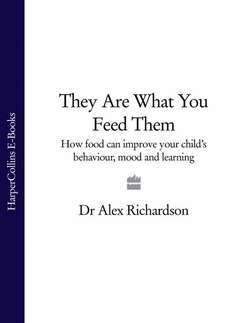Читать книгу They Are What You Feed Them: How Food Can Improve Your Child’s Behaviour, Mood and Learning - Dr Richardson Alex - Страница 87
Iron
ОглавлениеIron deficiency leads to anaemia, because iron is needed (with copper) to make the red blood cells that carry oxygen around your body. Even a mild lack of iron can cause physical fatigue and lack of energy, and can also impair mental performance.
Many children in the UK, especially teenage girls, don’t get enough iron. Around 10 per cent of children under 4 years of age and almost one in two girls aged between 11 and 18 years had seriously iron-deficient diets, and biochemical measures of iron status and metabolism painted a similar picture.25 One study from France reported low ferritin (used by your body to store iron safely) in children with ADHD,26 but controlled trials are still needed to find out if more dietary iron might help in this condition. As we saw in the last chapter, different children with this diagnostic label can vary greatly, and in another study from Taiwan, both dietary and blood measures indicated increased iron in children with ADHD.27
The frequent occurrence of ‘restless legs syndrome’ and disturbed sleep patterns in children with ADHD may be because of a deficiency in iron.28
Only about 10 per cent of dietary iron (mainly from meat) is in a readily absorbed form called ‘haem’ iron. The other 90 per cent comes as ‘non-haem’ iron (found in fruits, vegetables, dried beans, nuts and grains); how much of this you absorb varies with your iron status and other factors.
Vitamin C helps considerably (giving yet another reason why your child should eat her fruits and vegetables!). The presence of any haem iron (or even the use of cooking pots made of cast iron) can also boost absorption.
By contrast, substances called ‘phytates’—found in bran, soya, whole grains and legumes—can reduce absorption, as they bind to iron (and other metals like zinc and calcium). Tannin and other substances found in tea and coffee can also reduce iron absorption, so don’t let your pale, tired child try these for ‘energy’.
As meat is the best source of absorbable iron, vegetarians need to take care to get enough, particularly as some staple vegetarian foods are rich in phytates. Some foods (like breakfast cereals) are fortified with iron—but do weigh this against the rest of their content! If they’re high in sugar, for example, don’t bother. Find some healthy sources instead.29
If your child does seem pale, listless and lacking in energy (and/or unduly inattentive or hyperactive), try asking your doctor to test for iron deficiency. Iron supplements aren’t necessarily the best solution, though. This is because if there’s an imbalance of gut bacteria (see the next chapter) some of the ‘bad’ bacteria love iron, and may gobble this up so it doesn’t even reach your child. Discuss this with your doctor, and take further advice if needed.30
